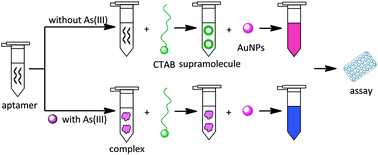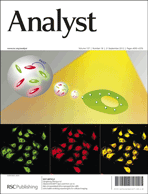This paper reports the colorimetric and resonance scattering (RS)-based biosensor for the ultrasensitive detection of As(III) in aqueous solution via aggregating gold nanoparticles (AuNPs) by the special interactions between arsenic-binding aptamer, target and cationic surfactant. Aptamers and the cationic surfactant could assemble to form a supramolecule, which prevented AuNPs from aggregating due to the exhaustion of cationic surfactant. The introduction of As(III) specifically interacted with the arsenic-binding aptamer to form the aptamer–As(III) complex, so that the following cationic surfactant could aggregate AuNPs and cause the remarkable change in color and RS intensity. The results of circular dichroism (CD) and scanning probe microscope (SPM) testified to the formation of the supramolecule and aptamer–As(III) complex, and the observation of transmission electron microscope (TEM) further confirmed that the aggregation of AuNPs could be controlled by the interactions among the aptamer, As(III) and cationic surfactant. The variations of absorbance and RS intensity were exponentially related to the concentration of As(III) in the range from 1 to 1500 ppb, with the detection limit of 40 ppb for the naked eye, 0.6 ppb for colorimetric assay and 0.77 ppb for RS assay. Additionally, the speed of the present biosensor was rapid, and it also exhibited high selectivity over other metal ions with an excellent recovery for detection in real water samples, suggesting that the proposed biosensor will play an important role in environmental detection.

You have access to this article
 Please wait while we load your content...
Something went wrong. Try again?
Please wait while we load your content...
Something went wrong. Try again?


 Please wait while we load your content...
Please wait while we load your content...